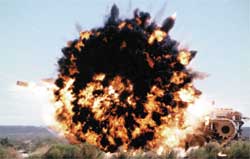Pakistan, the C.I.A., and the “Hazards of Robotic Warfare”

I can’t blog forthrightly about the remote-control assassinations detailed this week in The New Yorker without first alerting readers to my bias — a bias that’s more about pragmatism and temperament than about ideology or respect for U.S. law.
For the same reasons that this Global Pedestrian blog of mine aims to park the car and discover distant places at walking speed, I’ve concluded that America helps itself in warfare by relying on face-to-face counterinsurgency and undermines itself by allowing the C.I.A. to shoot missiles from unmanned drones hovering over Pakistan. Those clandestine drones are the focus of “The Predator War,” Jane Mayer’s investigative piece in the current issue of The New Yorker.
Next door to Pakistan, in Afghanistan, unmanned aircraft also fly missions. But America’s top commander there has judged that “air power contains the seeds of our own destruction” and ordered troops to “think of how you would expect a foreign army to operate in your neighborhood, among your families and your children, and act accordingly.”
According to Mayer’s reporting, “officials credit drones (over Pakistan) with having killed more than a dozen senior Al Qaeda leaders and their allies in the past year, eliminating more than half of the C.I.A.’s twenty most wanted ‘high value’ targets.”
That’s the good part. The bad part — or the acceptable collateral damage, if you prefer to look at it that way — is that drones don’t just kill their main targets. Mayer gives several examples, including this one:
“… the recent campaign to kill (Pakistani Taliban leader) Baitullah Mehsud offers a sobering case study of the hazards of robotic warfare. It appears to have taken sixteen missile strikes, and fourteen months, before the C.I.A. succeeded in killing him. During this hunt, between two hundred and seven and three hundred and twenty-one additional people were killed, depending on which news accounts you rely upon.”
Mayer quotes a report written by counterinsurgency specialist David Kilcullen and other experts for the Center for a New American Security: “Every one of these dead non-combatants represents an alienated family, a new revenge feud, and more recruits for a militant movement that has grown exponentially even as drone strikes have increased.”
Those alienated families, these new revenge feuds may be acceptable costs for killing terrorists. Part of why I flagged my bias at the start of this post is to alert readers to something that is always true: that you should all be making up your own minds.
Mayer concludes her piece with Bruce Riedel, a former C.I.A. officer who has advised the Obama Administration on Pakistan:
“He likened the drone attacks to ‘going after a beehive, one bee at a time.’ The problem is that, inevitably, ‘the hive will always produce more bees.’ But, he said, … ‘It’s really all we’ve got to disrupt Al Qaeda. The reason the Administration continues to use it is obvious: it doesn’t really have anything else.'”
There are many more facets of the drone program than I have room to discuss here. Mayer covered some of them in an interview with NPR’s Terry Gross and in a Q&A for newyorker.com.





